Sunday, November 27, 2005
DAIKOKU-SAMA FESTIVAL IN INO
November 23, 2005
 Sugimoto Shine is located in a small town called Ino, which is about 20 minutes by car from Kochi city. The name Sugi (cedar) -moto is said to be related to the cedar tree that had something to do with the foundation of the shrine or the person who played a key role in that. Anyway, there enshrined are three gods including Ookuninushi no mikoto, commonly called Daikoku-san, who is said to have made the island of Japan, according to the Shinto legend.
Sugimoto Shine is located in a small town called Ino, which is about 20 minutes by car from Kochi city. The name Sugi (cedar) -moto is said to be related to the cedar tree that had something to do with the foundation of the shrine or the person who played a key role in that. Anyway, there enshrined are three gods including Ookuninushi no mikoto, commonly called Daikoku-san, who is said to have made the island of Japan, according to the Shinto legend.
Gods at this shrine are believed to give people prosperity, bumper crops, good marriage and family wealth, etc. and two big festivals are held there every year, one in spring and the other in autumn. Last Wednesday, Novermber 23rd, was the day for the autumn Daikoku-sama festival, and I really enjoyed it.
On that day, the gods at the shrine take a short trip to nearby riverbank. The object of the worship is carried in traditional mikoshi or miniature shrine, and local people dress up in ancient costumes and accompany the gods’ excursion. Gods’ short trip like this is called onabare in Kochi (I don’t remember hearing this word in my hometown, though). On the riverbank, people entertain god(s) with traditional dances.
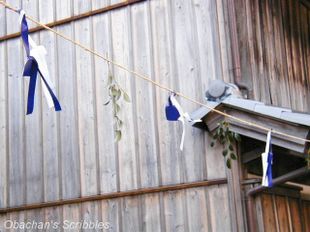 It was such a fine autumn day and the weather was absolutely perfect. I arrived at Ino town around noon. The road leading to the shrine was decorated with shimenawa. This rope tells that this is a sacred area where god-related events take place. I know those small branches are supposed to chase the evils away, but not sure why the color of the paper strips need to be white and purple. (Maybe related to ying-yang?)
It was such a fine autumn day and the weather was absolutely perfect. I arrived at Ino town around noon. The road leading to the shrine was decorated with shimenawa. This rope tells that this is a sacred area where god-related events take place. I know those small branches are supposed to chase the evils away, but not sure why the color of the paper strips need to be white and purple. (Maybe related to ying-yang?)
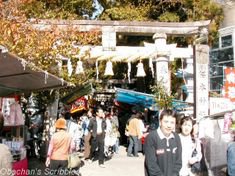 This shrine is said to be more than 1000 years old.
This shrine is said to be more than 1000 years old.
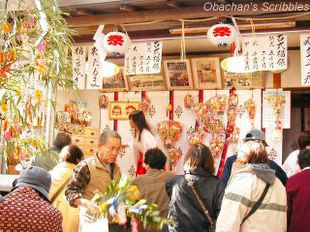
Lucky charms sold at the shrine (click to enlarge)
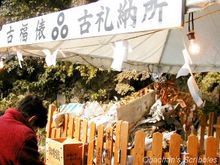 You can keep the decorated bamboo grass at home and return it here when it became old and turned brown.“Three circles" on this bannerr seems to be the symbol of this shrine ( maybe meaning three gods??) ; I saw it on almost everything there.
You can keep the decorated bamboo grass at home and return it here when it became old and turned brown.“Three circles" on this bannerr seems to be the symbol of this shrine ( maybe meaning three gods??) ; I saw it on almost everything there.
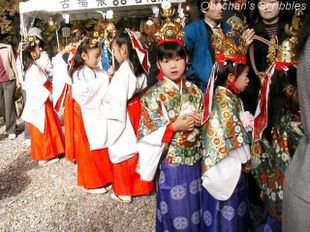
Kids waiting inside the shrine before onabare (click to enlarge)
At 13:00, onabare left the shrine and I walked through the town with this traditional parade.
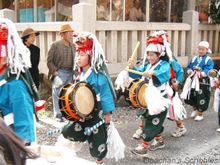
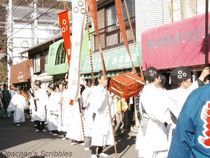

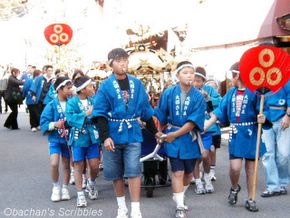
Mikoshi carried by boys

Mikoshi carried by girls
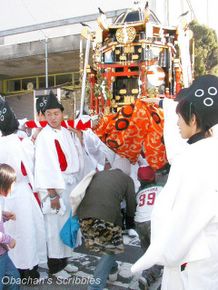 Sugimoto Shrine's lacquer-coated mikoshi (miniature shrine) is said to have been made about 700 years ago and designated as a national important cultural asset. I heard that the one they actually carry around in onabare parade (see photo) is a replica, which makes sense. They say that you can stay healthy if you go under the mikoshi during onabare, so they had to stop many times to let people pass under the miniature shrine.
Sugimoto Shrine's lacquer-coated mikoshi (miniature shrine) is said to have been made about 700 years ago and designated as a national important cultural asset. I heard that the one they actually carry around in onabare parade (see photo) is a replica, which makes sense. They say that you can stay healthy if you go under the mikoshi during onabare, so they had to stop many times to let people pass under the miniature shrine.
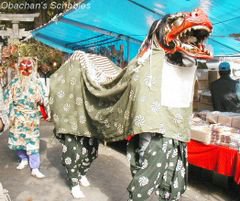 If you would go through the town with obanare, you'd probably wonder why you keep hearing small kids crying so hard here and there. Well, it’s because of this traditional custom. It is said that kids who had their heads bitten by this lion will grow smart and healthy. (Western psychologists would probably worry about the effect of this traumatic experience in early childhood.)
If you would go through the town with obanare, you'd probably wonder why you keep hearing small kids crying so hard here and there. Well, it’s because of this traditional custom. It is said that kids who had their heads bitten by this lion will grow smart and healthy. (Western psychologists would probably worry about the effect of this traumatic experience in early childhood.)
 Sure she doesn't look happy.
Sure she doesn't look happy.
* The lion just pretends to bite kids. It never actually hurts kids' heads.
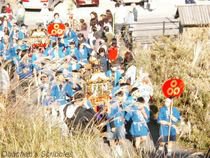

Onabare going up to the riverbank.
On the riverbank, kids performed traditional dances to entertain god(s). The audience was told that they had practiced the dance since summer.
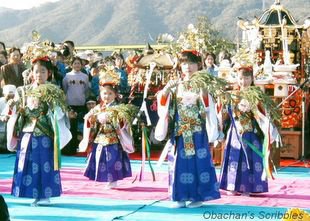
Girls' dance with cedar branches (click to enlarge)
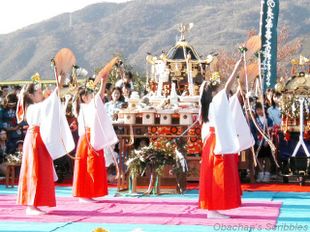
Fan dance (click to enlarge)

Bell dance
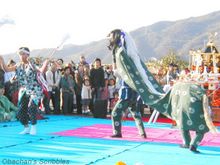
Traditional lion dance. This comical dance seems to be about a fight between a drunken man and a lion over a good-luck bamboo branch.
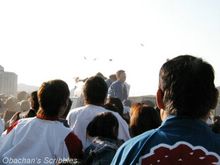 After the dance, rice cakes were thrown to onlookers. The rice cakes are associated with blessing of the god(s), so people really get enthusiastic to catch as many as possible. I was having a hard time trying to take some shots with my stupid old digital camera, so I couldn’t get any rice cakes!! It was my very first time since my childhood that I got none in this kind of rice-cake throwing ceremony! (Honestly that was part of the reason why I bought a new digital camera -- I was too mad!)
After the dance, rice cakes were thrown to onlookers. The rice cakes are associated with blessing of the god(s), so people really get enthusiastic to catch as many as possible. I was having a hard time trying to take some shots with my stupid old digital camera, so I couldn’t get any rice cakes!! It was my very first time since my childhood that I got none in this kind of rice-cake throwing ceremony! (Honestly that was part of the reason why I bought a new digital camera -- I was too mad!)
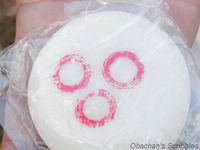
An old woman let me take a shot of the rice cake.
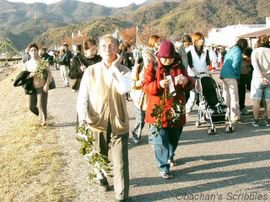
People going home with holly sakaki branches in hand, which, like the rice cakes, should give them good-luck.
Though I didn’t get a sakaki branch or rice cake, I believe that the photos I took there that day also "absorbed" gods’ blessing pretty much.
Hope these shots bring you a good luck, too. :)
 Sugimoto Shine is located in a small town called Ino, which is about 20 minutes by car from Kochi city. The name Sugi (cedar) -moto is said to be related to the cedar tree that had something to do with the foundation of the shrine or the person who played a key role in that. Anyway, there enshrined are three gods including Ookuninushi no mikoto, commonly called Daikoku-san, who is said to have made the island of Japan, according to the Shinto legend.
Sugimoto Shine is located in a small town called Ino, which is about 20 minutes by car from Kochi city. The name Sugi (cedar) -moto is said to be related to the cedar tree that had something to do with the foundation of the shrine or the person who played a key role in that. Anyway, there enshrined are three gods including Ookuninushi no mikoto, commonly called Daikoku-san, who is said to have made the island of Japan, according to the Shinto legend.Gods at this shrine are believed to give people prosperity, bumper crops, good marriage and family wealth, etc. and two big festivals are held there every year, one in spring and the other in autumn. Last Wednesday, Novermber 23rd, was the day for the autumn Daikoku-sama festival, and I really enjoyed it.
On that day, the gods at the shrine take a short trip to nearby riverbank. The object of the worship is carried in traditional mikoshi or miniature shrine, and local people dress up in ancient costumes and accompany the gods’ excursion. Gods’ short trip like this is called onabare in Kochi (I don’t remember hearing this word in my hometown, though). On the riverbank, people entertain god(s) with traditional dances.
 It was such a fine autumn day and the weather was absolutely perfect. I arrived at Ino town around noon. The road leading to the shrine was decorated with shimenawa. This rope tells that this is a sacred area where god-related events take place. I know those small branches are supposed to chase the evils away, but not sure why the color of the paper strips need to be white and purple. (Maybe related to ying-yang?)
It was such a fine autumn day and the weather was absolutely perfect. I arrived at Ino town around noon. The road leading to the shrine was decorated with shimenawa. This rope tells that this is a sacred area where god-related events take place. I know those small branches are supposed to chase the evils away, but not sure why the color of the paper strips need to be white and purple. (Maybe related to ying-yang?) This shrine is said to be more than 1000 years old.
This shrine is said to be more than 1000 years old.
Lucky charms sold at the shrine (click to enlarge)
 You can keep the decorated bamboo grass at home and return it here when it became old and turned brown.“Three circles" on this bannerr seems to be the symbol of this shrine ( maybe meaning three gods??) ; I saw it on almost everything there.
You can keep the decorated bamboo grass at home and return it here when it became old and turned brown.“Three circles" on this bannerr seems to be the symbol of this shrine ( maybe meaning three gods??) ; I saw it on almost everything there.
Kids waiting inside the shrine before onabare (click to enlarge)
At 13:00, onabare left the shrine and I walked through the town with this traditional parade.




Mikoshi carried by boys

Mikoshi carried by girls
 Sugimoto Shrine's lacquer-coated mikoshi (miniature shrine) is said to have been made about 700 years ago and designated as a national important cultural asset. I heard that the one they actually carry around in onabare parade (see photo) is a replica, which makes sense. They say that you can stay healthy if you go under the mikoshi during onabare, so they had to stop many times to let people pass under the miniature shrine.
Sugimoto Shrine's lacquer-coated mikoshi (miniature shrine) is said to have been made about 700 years ago and designated as a national important cultural asset. I heard that the one they actually carry around in onabare parade (see photo) is a replica, which makes sense. They say that you can stay healthy if you go under the mikoshi during onabare, so they had to stop many times to let people pass under the miniature shrine. If you would go through the town with obanare, you'd probably wonder why you keep hearing small kids crying so hard here and there. Well, it’s because of this traditional custom. It is said that kids who had their heads bitten by this lion will grow smart and healthy. (Western psychologists would probably worry about the effect of this traumatic experience in early childhood.)
If you would go through the town with obanare, you'd probably wonder why you keep hearing small kids crying so hard here and there. Well, it’s because of this traditional custom. It is said that kids who had their heads bitten by this lion will grow smart and healthy. (Western psychologists would probably worry about the effect of this traumatic experience in early childhood.) Sure she doesn't look happy.
Sure she doesn't look happy.* The lion just pretends to bite kids. It never actually hurts kids' heads.


Onabare going up to the riverbank.
On the riverbank, kids performed traditional dances to entertain god(s). The audience was told that they had practiced the dance since summer.

Girls' dance with cedar branches (click to enlarge)

Fan dance (click to enlarge)

Bell dance

Traditional lion dance. This comical dance seems to be about a fight between a drunken man and a lion over a good-luck bamboo branch.
 After the dance, rice cakes were thrown to onlookers. The rice cakes are associated with blessing of the god(s), so people really get enthusiastic to catch as many as possible. I was having a hard time trying to take some shots with my stupid old digital camera, so I couldn’t get any rice cakes!! It was my very first time since my childhood that I got none in this kind of rice-cake throwing ceremony! (Honestly that was part of the reason why I bought a new digital camera -- I was too mad!)
After the dance, rice cakes were thrown to onlookers. The rice cakes are associated with blessing of the god(s), so people really get enthusiastic to catch as many as possible. I was having a hard time trying to take some shots with my stupid old digital camera, so I couldn’t get any rice cakes!! It was my very first time since my childhood that I got none in this kind of rice-cake throwing ceremony! (Honestly that was part of the reason why I bought a new digital camera -- I was too mad!)
An old woman let me take a shot of the rice cake.

People going home with holly sakaki branches in hand, which, like the rice cakes, should give them good-luck.
Though I didn’t get a sakaki branch or rice cake, I believe that the photos I took there that day also "absorbed" gods’ blessing pretty much.
Hope these shots bring you a good luck, too. :)
posted by obachan, 11/27/2005 02:12:00 PM


